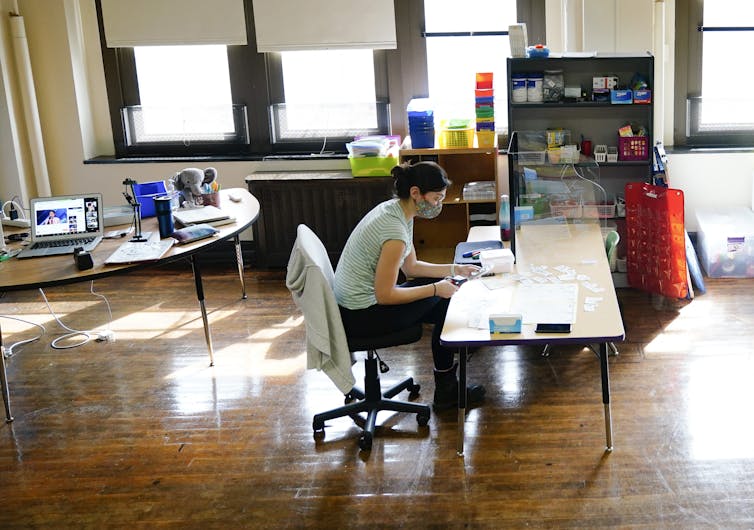
In an episode of Abbott Elementary, the sitcom about a group of teachers in an under-resourced Philadelphia school, novice teacher Janine takes to TikTok. The joke is that she needs to use TikTok to fundraise to get her classroom much needed school supplies.
Although played for laughs in this award-winning show created by Quinta Brunson, one education blogger wrote: “In tonight’s episode … we learned the lesson that all teachers know — schools are underfunded, and [supply] wishlists have the ability to make teachers REALLY happy.”
Actually, crowdfunding for schools in real life can provide immediate and necessary resources. There is even early research to say that crowdfunding leads to better learning outcomes for students.
In this season of giving, that is something to think about as you decide where to put your money.
Although individual donations cannot compensate for the structural conditions of general underfunding and inequitable funding of public schools, a crowdfunded teacher’s classroom may have better outcomes than one that is not.
Diverse learning needs
One study from California showed how extra funds from teacher crowdfunding efforts allowed teachers to run projects that fully address the diverse learning needs of their students.
Another study shows how educators’ crowdfunding efforts are linked to higher test scores for students, even when the crowdfunding is unsuccessful.
However, any benefits of crowdfunding in education should not gloss over the fact that there is a systematic lack of public support for public education teachers. This is especially relevant for the most under-resourced schools: those that serve low-income communities, both urban and rural.
This is part of the broader crisis in public education.
Pervasive under-resourcing of schools
To meet the needs of their students and classrooms, educators in the United States have been paying out-of-pocket or using private sponsors to pay for books, software, pencils and paper, classroom decorations, prizes, snacks and even cleaning supplies.

According to an estimate by the National Education Association, 90 per cent of teachers spend money on their students. This year, many will spend an average of US$820, which is a $500 increase since before the pandemic.
No wonder educators are turning to crowdfunding sites, like Amazon Wishlists and DonorsChoose, the not-for-profit crowdfunder which makes “it easy for anyone to help a teacher in need.”
Read more: TikTok is more than just a frivolous app for lip-syncing and dancing – Podcast
In a sign of support for teachers, as well as to take a stand on the dismal state of funding for education in the U.S., the American Federation of Teachers (AFT) donated $400,000 to educators through DonorsChoose in March 2022.
At the time of the donation, AFT President Randi Weingarten said:
“We’re spreading hope and expressing gratitude to teachers and school staff who’ve sacrificed so much to ensure a better life for our children and our communities. And we’re also shining a spotlight on decades of underfunding and the urgent need to invest in our kids and the schools they attend.”
Job satisfaction is dropping; strikes are increasing
The teaching profession was already facing challenges before the COVID-19 pandemic. The pandemic intensified stressors on educators and the public school system. Similar to Canada, teachers in the U.S. face low salaries as well as inadequate resources for academic programming, support staff and social supports. Staffing shortages among teachers that began prior to the pandemic are now reaching crisis levels.
Contributing to these challenges is the fact that public schools are increasingly sites of political conflict, as conservative activists and state legislatures take aim at, among other things, how to teach about race and LGBTQ+ rights and contest books stocked in classrooms and libraries.
Among public educators, job satisfaction is low.
As a testament to the dissatisfaction of educators being asked to do too much with too little, 2022 saw another wave of strikes among K-12 teachers’ unions.

Strike demands include pay increases; resources for academic programming; smaller class sizes; investment in counsellors, nurses and social workers; and addressing hot and poorly ventilated classrooms, among other issues.
Educators also continue to leave the profession.
A report from the National Education Association identifies under-resourcing and the expectation that educators will spend their personal money as factors driving educators away from the profession.
Public school system needs investments
Canada is also seeing educators leaving the profession and increased strike mobilization. In both countries, these are signs that the people doing the critical work of education feel that their conditions of work are unsustainable.
The benefits of a good public education system include a healthy community and democracy and therefore we need to ensure that students have access to them. Crowdfunding is one solution to help fill immediate resource shortages. At the same time, we also need to demand policies that make necessary investments in our public schools.
Rachel K. Brickner does not work for, consult, own shares in or receive funding from any company or organisation that would benefit from this article, and has disclosed no relevant affiliations beyond their academic appointment.
This article was originally published on The Conversation. Read the original article.







